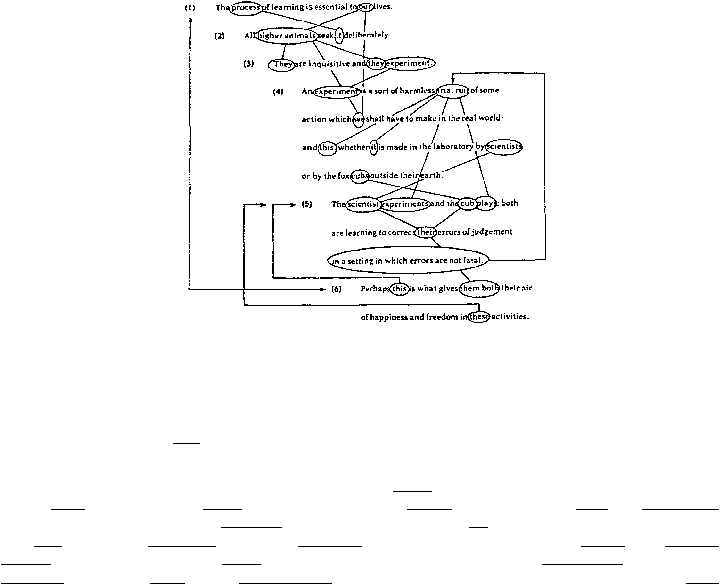
59
1. Pronouns. The «we» in sentence 5 hooks back not only to «higher animals» but to the readers themselves,
referred to in the first sentence with «our».
2. Summary nouns and pronouns. The «this» in sentence 6 pulls together the entire paragraph by referring to
«experiment» and «play» in sentence 5 and to the «process of learning» in sentence 1. Sometimes a summary
noun will do this job. For example, sentence 6 might have read: «Perhaps the nature of trial run is what gives. .»
3. Repeated words. «Scientist», «learning», and «errors» reappear.
4. Repeated stems. Bronowski used «an experiment» (the noun) followed by «experiments» (the verb).
5. Rewording of the same idea. A «harmless trial run» is later redefined as a «setting in which errors are not
fatal».
6. Punctuation. Colons usually tell us that an explanation, an example or a list follows. Semicolons connect
two main clauses that generally are closely related.
7. Parallel construction. The grammatically parallel construction of «the scientist experiments and the cub
plays» (sentence 5) emphasizes the parallel connection Bronowski wishes to make.
Cues and Signals Used to Establish Coherence
D: A passage with many word and phrase cues
Source: Jacob Bronowski. The Common Sense of Science (Cambridge: Harvard University Press, 1953).
3.1 In the following paragraph the cues and signals that establish coherence have been underlined. Study
each one and decide what type of coherence device it is. (Refer to the list of devices preceding the Bronowski
text above).
Rescue dogs are often specially trained to work in areas where a bomb or earthquake has buried people in
debris. Their job is to locate where the persons are buried so that rescuers can dig them out before they
suffocate or die of other injuries. Since the dog must guide rescuers to the spot, he must be willing to sit and
bark until help comes. As a result some dogs, including collies, shepherds, airedales, and, in fact, most working
breeds, can be trained for rescue; others can't. Spaniels, setters, and some hounds, for example, refuse to bark
once they have found their person. Although they would bark at home if someome came to the door, these

